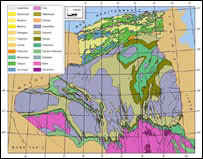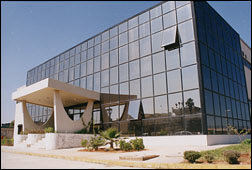 MINING FEVER MINING FEVER |
Another primary concern of the reforms is the mining sector, which has already taken steps towards liberalization. Chakib Khelil, Minister for Energy and Mines, notes: "although it has not yet been possible to sell nationally-owned mines and quarries to the private sector, they have been given to public enterprises in the form of concessions. We are also passing new regulation that will allow operators to exploit concession sites for a limited period of time. Five amendments have been proposed for the mining law, the most important of which involved the suppression of discrimination against foreign investors."
The concessions should allow local and foreign investors to invest in the exploration and exploitation of the untapped mining resources. Apart from the traditional iron, salt or marble deposits, some 32 additional mineral deposits have been identified; among them mention should be made of gold, wolfram, tin, silver, diamonds, mercury, as well as precious and semi-precious stones. Seven public companies are presently exploiting and marketing these minerals: FERPHOS, ASMIDAL, ENASEL, ENAMARBRE, ENOB, ENOR and ENG. In 1997 and 1998, the country experienced a slight improvement in iron production (+ 131 million tons), phosphate (+ 87 million tons) and salt (+ 35 million tons). It is worth noticing that FERPHOS produced 1,155 million tons of phosphate in 1998, when its production capacity is about 1,500 million tons. Given the importance of the Algerian mining sector, none of these public enterprises has on its own the financial strength to develop new deposits. The State being not in a position to pump money into these companies, the government had no alternative but to open up to local and foreign investments.
Looking now at the reserves, they have been estimated at 3.5 billion tons for iron, 2 billion for phosphates, 1.6 billion for lead-zinc and over 1 billion tons for salt. Regarding marble, reserves are over 24 million m3 (its production only exceeded 35,000 m3 in 1999). Most of the deposits are under-utilised, while a fair number have been left aside.
As far as concessions are concerned, small and medium sized mines were primarily targeted, leading to the concession of 24 mines, with 15 deposits in the North of the country (marble and decorative stones), 11 deposits at Beni-Abbes and at In-Salah (clay), 4 deposits at Tlemcen and M'Sila (plaster), 5 at Tizi-Ouzou, Tipaza, Saïda (beryllium), 6 deposits of sand, 2 deposits of zinc, 1 of copper, 9 deposits of salt and finally 3 deposits of gold of which two are in the South and one at Boudouaou.

Click to enlarge (204ko)
The State's key instrument for the liberalization of the mining sector is the ORGM (National Bureau of Mining and Geological Research).The mission of this organization is to oversee all public service related to geology, from mining exploration to promotion. The scope of ORGM' s activities includes commercial projects and joint venture partnerships, in addition to representing companies such as De Beers, BHP, Rex Mining and Breakwater Resources.
|
The company is further involved with mining concessions insofar as it is responsible for providing potential investors with the necessary information to make a successful bid. According to Mohamed Tahar Bouarroudj, General Manager of the ORGM, "the mining law does not distinguish between public and private investors, nor between national and foreign ones; it will allow the repatriation of the total investment in a mining project. Foreign mining companies will no longer have to be in partnership with public enterprises in order to invest in the mining sector." As to the effective opening of the market, which has already begun, Bouarroudj confirms: "in view of the positive results, a second promotional campaign of development for small and medium sized mines has been launched in October 2000".
Regarding future opportunities, Bouarroudj points out "foreign investors can expect numerous international tenders for the exploitation of diamond, gold and other basic metals."
When referring to the country's mining potential, the ORGMGeneral Manager considers that "one of the major trump cards that Algeria has in his hand is the existence of an important geological, geo-chemical and geophysical infrastructure"; this includes geological maps of the North of the country, on a scale of 1:50.000 covering about 80% of the cartographic landscape; those of the South on a scale of 1:200.000 cover almost 100%, as well as the geophysical maps taken from the air on scales of 1:100.000 and 1:500.000 (available in numerical forms) and also for the aero magnetic and aero spectrometric map. "The results of Algeria's thirty year exploration program have revealed important poly-metallic deposits (Pb, Zn, Cu), as well as deposits of gold, iron, manganese, mercury, wolfram-tin, tantale, uranium, phosphates, caesium, barite, marble and caoline; several zones with strong potential have been identified in the North and South of the country".
An important beneficiary, AGENOR(Agence Nationale pour la Transformation et la Distribution de l'Or) will process and sell the country's newly discovered gold production in the South of the country.

According to Mohamed-Seghir Benamara, Chairman of AGENOR, "the gold market in Algeria is about 10 metric tons a year". He adds: "we are positioning ourselves to capitalize on this new business opportunity; we are presently working with South Africans to adopt the latest technology, while looking for more partnerships." AGENOR is also developing other projects such as the refining of platinum, and has undertaken discussions for cyanide production (which should entirely be exported to the American market).
AGENOR is also ready to open its capital to a foreign partner. "The State suggested an IPO over 20%, but we can do much better. In fact we can sell up to 49% to a strategic investor, and we can also create subsidiaries - an option offered to a number of potential partners who might wish to keep their brand name" suggests Benamara. |

